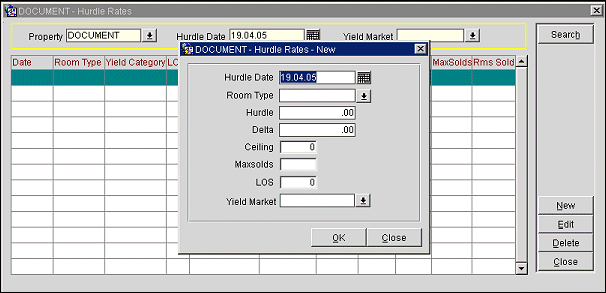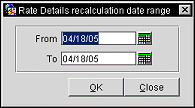
Hurdle Rates
The yield management software receives messages from OPERA in XML format and evaluates the changes that have been made in OPERA. Based on these changes as well as historical fields, the yield management software determines hurdle rates and deltas (changes), which are to be sent through XML messages. OPERA then uses these hurdle rates to determine rate code/room type availability at the time of making a reservation.
OPERA provides the application program interfaces to extract yield related data from OPERA as well as to write data to OPERA. Except for the Business Event handling which is part of OPERA there is no other active process in OPERA to support yield systems. To send or receive information any external yield system is required to establish a connection to the OPERA system and call the application program interfaces as specified.
Data sent from a third party vendor to OPERA will be done using an application program interface to communicate, and a data string to transmit values. Hurdle rates will be submitted in local currency defined in Configuration>Property>Property Details.
Before any consideration is made concerning hurdle rates OPERA first checks its own rate availability controls to determine whether the rate code is open or closed and will be displayed on the rate availability grid. OPERA completes the following checks to determine whether or not a rate code is available:
There are various possible status codes for rates:
Open. No restrictions on the rate code.
Closed. No booking can be accepted for either arrival on or staying through the Selected stay.
Closed to Arrival. No booking can be made for arrival on the selected date.
Closed to Departure. No booking can be made for departure on the selected date.
Minimum Length of Stay. No booking can be made for less than the minimum number of nights defined for the selected arrival date.
Maximum Length of Stay. No booking can be made for less than the maximum number of nights defined for the selected arrival date.
Minimum Stay-Through. No booking can be made for less than the minimum number of nights defined if the restricted date falls within any part of the stay.
Maximum Stay-Through. No booking can be made for more than the maximum number of nights defined if the restricted date falls within any part of the stay.
Open Only for Day Use. Only bookings with zero nights (i.e. day use) will be offered this Rate code.
Minimum Advance Booking Days. No booking can be made after the date of the minimum advance booking days on the rate header or restrictions in reference to the arrival date of the stay.
Maximum Advance Booking Days. No booking can be made before the date of the maximum advance booking days on the rate header or restrictions in reference to the arrival date of the stay.
Once OPERA's standard rate availability logic has been applied, OPERA will test to see if the rate code/room type meets the hurdle rate criteria.
In short, if a rate amount meets or beats the bid price/hurdle, it is then visible within the rate query. OPERA compares the set bid price/hurdle against the rate code's rateable value. Rateable value is calculated as the stay cost plus yield adjustments (which can be positive or negative amounts). Then the calculated rateable value is compared against the hurdle to determine if the rate code is to be made available in the rate query. The rate query shows the rate amount, not the rateable value.
Before you can use the Business Events interface, a hurdle rate license code must be purchased and activated under the Configuration>Setup>Licenses menu. When this is done, you will have access to the Hurdle Rate menu, located under the Configuration>Rate Management>Yield>Hurdle Rates menu selection.
Also the yield management software must be located either on a server or locally on a PC connected to the network.
A User Permission located under PMS RATES, called Hurdle Override, has been added to OPERA. If this permission is assigned, you can make changes to the proposed hurdle rate from the Hurdle Rates menu.
Note: In OCM, hurdle rates can also be viewed, created and edited (OCM>Configuration>Hurdles). However, in OCM in MyFidelio mode, the Hurdle Rates screen is read-only.

To find specific hurdle rates, enter your search options and select the Search button.
Property. Property for which you wish to see hurdle rates.
Hurdle Date. Date for which you wish to find hurdle rates.
Yield Market. Select the down arrow and choose the yield market type you wish to search for. Available if the OPP_OPUS OPERA Revenue Management System add-on license is active and the Rates>Yield Market Types application parameter is set to Y.
Note: Typically, hurdle rates are set automatically by a yield management system (such as ORMS or IDEAS) and would not be manually edited. If you manually edit a hurdle rate record, OPERA records the fact in the database by changing the Override field in the Hurdle Rates Table from blank to Y. The change is also recorded in the User Activity Log.
To edit an existing hurdle rate, highlight your choice and select the Edit button. To add a new hurdle rate, select the New button. The Hurdle Rate - New or Hurdle Rate - Edit screen appears. Provide the following information and select the OK button.
Note: When an active OXI Interface is present, OXI will transfer (in both directions) yield market type data from the Hurdle Rate. This data will be transferred in the HURDLE message. Yield Market Types will be handled as a single value (based on Yield Category/Date/Yield Market Type) to the hurdle. This will be the case ONLY when not referencing hurdles by LOS. Again the OXI handlers will process these messages both inbound and outbound
Hurdle Date. Date when this hurdle rate is effective.
Room Type. Select the down arrow and chose the room type for this hurdle rate.
Hurdle. Enter the amount of the hurdle rate. The value that must be reached in order for OPERA to display a rate code/room type on the rate grid.
Delta. Represents a monetary value, which is added to the hurdle rate for each additional room sold up to the ceiling. If the hurdle rate is set at $80.00 and the delta is $1.00, for the first room sold the rateable value needs to be $80.00 or more. For the second room the rateable value needs to be $81.00, for the third $82.00 and more up to the Ceiling at which time no additional delta values are added.
Ceiling. Enter the number of rooms to be sold to which the delta value should be added.
For example:
Hurdle is $90.00
Delta is $5.00
Ceiling is 3
The first reservation must achieve the hurdle value of $90.00.
The second reservation must achieve the hurdle value of $95.00.
The third reservation must achieve the hurdle value of $100.00.
The fourth reservation must achieve the hurdle value of $105.00.
All subsequent reservations must achieve the hurdle value of $105.00 until maxsolds is reached, at which point the date is restricted.
MaxSolds. Enter the maximum number of rooms to be sold in the room types linked to the yield category.
LOS. Enter the length of stay for this hurdle rate.
Yield Market. Select the down arrow and choose a yield market type for this hurdle rate. Available if the OPP_OPUS OPERA Revenue Management System add-on license is active and the Rates>Yield Market Types application parameter is set to Y.
Note: When saving changes from the configuration of Hurdle Rates only, not the Rate Query screen, you are prompted to enter the date range for which you wish to recalculate prevailing rate details. The default is the current business date.
OPERA uses the LOS 0 hurdles for stay patterns greater than the maximum configured LOS. For example, a guest arriving on 05/27 is staying for 3 nights. In this example hurdle records are configured only up to LOS 2. There is no record for LOS 3. In this case the LOS 0 values are used to calculate the hurdle of 310 for the 3-night stay: (95+95+120 = 310).
Arrival Date |
Room Type |
LOS |
Hurdle |
05/27/00 |
KNG |
0 |
95 |
05/27/00 |
KNG |
1 |
205 |
05/27/00 |
KNG |
2 |
315 |
05/28/00 |
KNG |
0 |
95 |
05/28/00 |
KNG |
1 |
205 |
05/28/00 |
KNG |
2 |
315 |
05/29/00 |
KNG |
0 |
120 |
05/29/00 |
KNG |
1 |
205 |
05/29/00 |
KNG |
2 |
315 |
Yield Management Software. This represents the yield company that calculates the actual hurdle rates which OPERA compares against.
Hurdle Rate. This represents the monetary hurdle value calculated by the yield management software after considering information extracted from OPERA’s tables. This is the value that must be reached in order for OPERA to display a rate code/room type on the rate grid. Hurdle rates are sometimes referred to as bid prices or opportunity costs. All values will be in the base currency.
Rateable Value. This represents a monetary value of OPERA's rate codes. The value is calculated by taking the rate itself and deducting or adding the associated adjustments. Adding an adjustment would increase the rateable value, attaching a [-] adjustment would decrease the rateable value.
Delta. This represents a monetary value, which is added to the hurdle rate for each additional room sold up to the ceiling. If the hurdle rate is set at $80.00 and the delta is $1.00, for the first room sold the rateable value needs to be $80.00 or more. For the second room the rateable value needs to be $81.00, for the third $82.00 and more up to the Ceiling at which time no additional delta values are added.
Ceiling. This is the number of rooms to be sold to which the delta value should be added.
Room Type. The Room Type is a 3 or 4 character code assigned to each room category. The room type is linked to a reservation so allowing OPERA to keep an inventory control on rooms available per room type.
Yield Category. This represents the yield management category. Each room type must be assigned to a yield category. Multiple room types can be assigned to the same category.
Rate Code. The rate code is a character description (CORP, RACK, WEEKEND1, WEEKEND2, etc.) for the rate.
Updsolds. This represents the number of rooms sold in the room types linked to the YIELD CATEGORY since the last update from the yield management software. Each time a room is sold or canceled for the particular date and yield category, this field will be updated.
Maxsolds. This represents the maximum number of rooms to be sold in the room types linked to the YIELD CATEGORY. Once the Updsolds equals this level no further rooms for the date and Yield category may be sold.
Blocks. No group business (blocks) will be evaluated for hurdles.
See Also